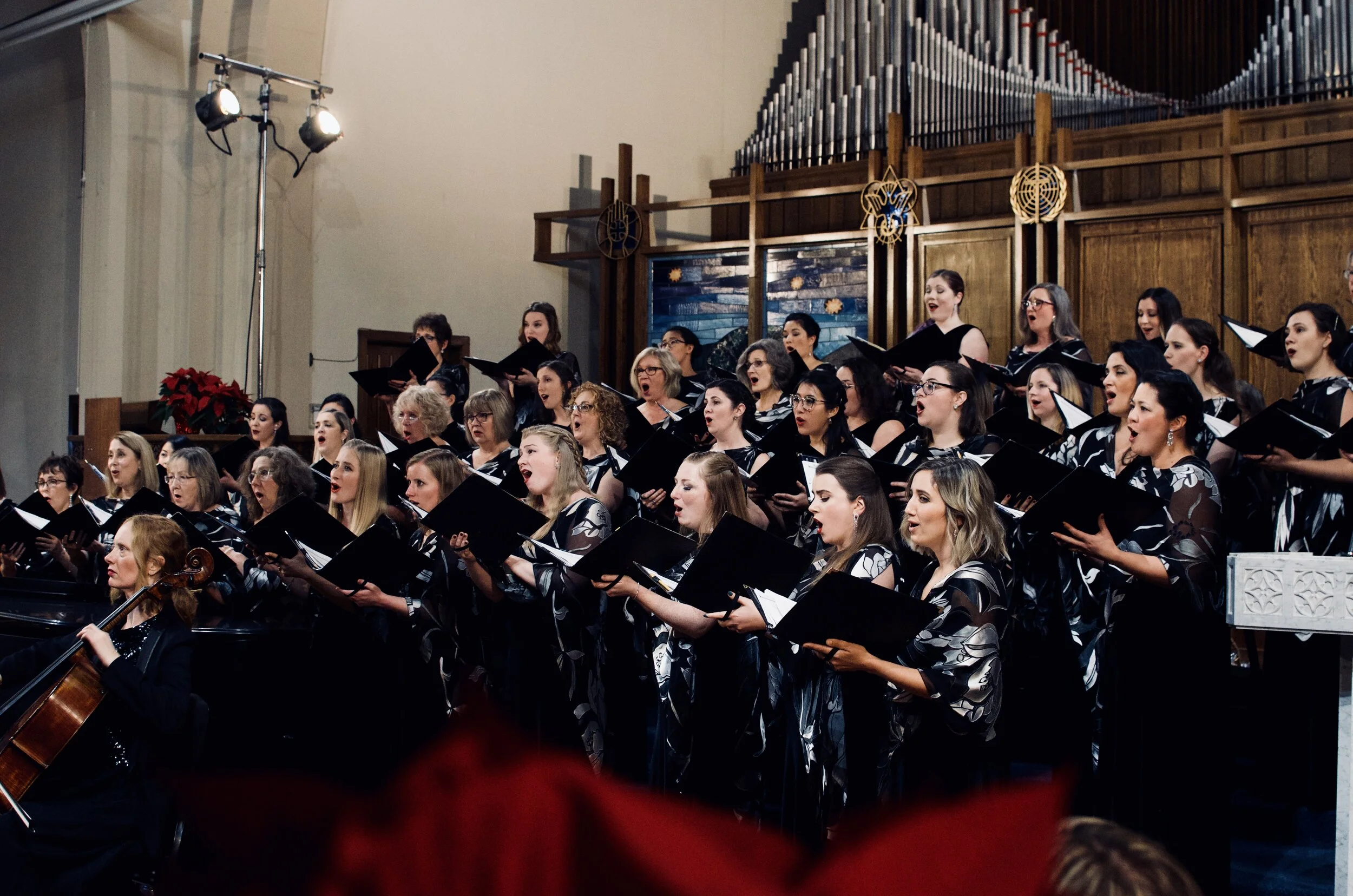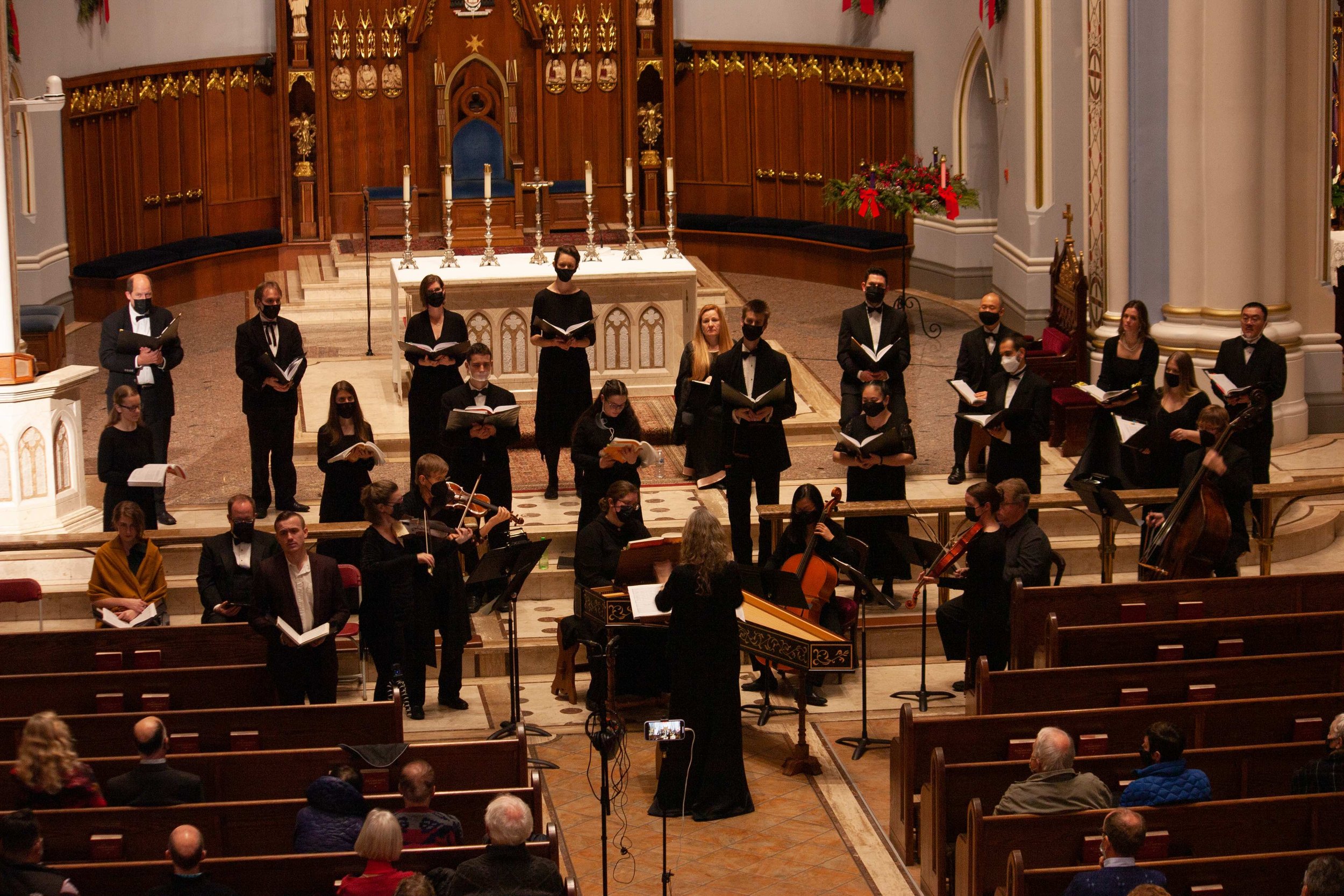The Light of Hope Returning, an animated concert and international collaboration, welcomes winter solstice
Elektra Women’s Choir, WomenSing, Allison Girvan, Kevork Mourad, and more join forces for the monumental virtual show
Elektra Womens’s Choir (phorographed pre-COVID-19) is part of the international collaborative project The Light of Hope Returning for 70 women’s voices.
The Light of Hope Returning takes place December 21 at 6 pm for free online. A Zoom session with the artists happens on December 20 at 2 pm.
WHEN BAY AREA conductor Ofer dal Lal, artistic director of WomenSing, first approached Los Angeles composer Shawn Kirchner to create a full-length piece for women’s choir two years ago, he had one ask: that the theme be one of hope. He never could have imagined just how apt that subject would be for the 2020 holiday season—nor just how ambitious the resulting work would become.
Dal Lal and Kirchner teamed up with Morna Edmundson, director of Vancouver’s Elektra Women’s Choir, for The Light of Hope Returning, an international collaboration and monumental virtual choral project with 70 female voices.
Premiering on winter solstice, the work features hand-drawn animation by Syrian-born New York-based visual artist Kevork Mourad and performances by Canadian soloist Allison Girvan and instrumentalists from the San Francisco Opera Orchestra.
Using dal Lal’s vision of an American-folk solstice oratorio as a jumping-off point, Kirchner—an accomplished, versatile pianist and songwriter as well as composer-in-residence at Los Angeles Master Chorale—created a piece that journeys across landscapes and moods, sometimes through traditional carols and new seasonal songs, several of which feature texts by Newbery Medalist Susan Cooper, author of the poem “The Shortest Day” and the award-winning Dark is Rising sequence. The Light of Hope Returning weaves together bluegrass-style piano, jazz saxophone, folk, gospel, and more. It’s all in celebration of the holidays, speaking to the changing of the seasons, the cycle of life, and the eternal conflict between darkness and light.
WomenSing premiered the composition last Christmas, and the plan was to do a West Coast tour of it this year. Although COVID-19 derailed those plans, it gave rise to others. In a conference call with Edmundson and Stir, dal Lal explains that the two artists had long discussed collaborating, but physically connecting such large ensembles (which together make up 70 singers) proved challenging. About six months ago, the idea for a pandemic-proof production came to mind.
“I reached out to Morna again and said, instead of us touring, what do you say about us touring virtually to Vancouver and you virtually touring here, and we collaborate our choirs and record together? Morna was onboard, though the magnitude of the project is something I wish we had started planning at least a year ago,” dal Lal says.
“It’s such a dramatic piece with so much imagery, and the music is so beautiful,” he says. “I was thinking of how we could really bring this out in a full-length virtual piece. It seemed to me it would be mundane or monotonous to see the faces of the singers for one hour on a screen. That’s how the idea for the illustration came about.”
Syrian artist Kevork Mourad combines video with live drawings in performances and installations around the globe.
Mourad, who was born in Qamishli and earned his Master of Fine Arts from the Yerevan Institute of Fine Arts in Armenia, is the only visual artist member of Yo-Yo Ma’s Silk Road Ensemble. Having collaborated with venerable institutions such as Metropolitan Museum of Art, Namibia’s OYO Dance Troupe, and the Aga Khan Foundation, he specializes in live performances during which he combines video and hand-drawn elements. When he’s drawing live, you can see his hand create works of art, which he then superimposes on existing illustrations to create layers of art. “It’s not going to look like any other virtual choir,” Edmundson says.
Girvan’s role is to guide the story; she takes on the role of an older woman who shares her wisdom—that we will get through this dark time and that light is coming.
“In the U.S., we’ve been out of hope for some time now, kind of feeling a lot of despair,” says dal Lal, who also leads the San Francisco Bay Area Chamber Choir and has taught choral conducting at California State University East Bay. “That came a lot in my conversations with Shawn: how to give people hope. Little did we know how much people would be wanting hope this year. November brought some hope to the U.S. Hope is exactly what the world needs to hear right now.”
WomenSing artistic director Ofer dal Lal.
Canadian soprano Allison Girvan.
To record the women singing, each choir approached things differently. Elektra found a studio in North Vancouver with individual rooms about the size of a walk-in closet, so they went in 10 at a time. In Orinda, California, where WomenSing is based, the chorists attended a large church in small groups, all spaced well apart and each with her own microphone. Thousands of digital files later, all of the voices were synced layered together via highly sophisticated software by sound engineers at Imrsv Sound, a post-production audio studio in Berkeley.
To get to that point, the singers rehearsed mainly via Zoom. “It’s true for every choir: Zoom is an entirely different experience,” dal Lal says. “It’s a great challenge. It puts a lot of accountability and responsibility onto each singer.”
Edmundson credits the singers for being willing to take on the project, for stepping outside of the norms of choral singing and their own comfort zones.
Elektra Women’s Choir director Morna Edmundson.
“It’s a bit vulnerable for a singer to record in a room by themselves when they’re used to being in a big group,” Edmundson says. “It’s a significant project that felt like we could really dig into it. Women’s choirs don’t have a lot of big pieces—we don’t have the Messiah or whole oratorios, pieces that are actually conceived from beginning to end as a whole evening. That’s rare. Shawn is worth shining a spotlight on, and I knew this would be the kind of work Elektra would want to share and introduce to other choirs that might be interested in programming it.”
It all came together through “luck, sheer tenacity and willingness” Edmundson says.
What further makes it unique, dal Lal says, is its lasting aspect.
“We mostly focus on live performances, not so much on recordings,” dal Lal says. “there’s something temporal about music: you sing it and then it’s gone. It’s not a statue. But this project is different. We’re creating something that will last and can be replayed. For us as musicians, in combination with the visual art, it’s very exciting.
“It’s been a tough year, and a tough four years for some,” he adds. “It’s a good time to gift people with art that moves them and makes them reflect. Art can really make difference.”
To watch the animated concert or attend the Zoom session with the artists, visit The Light of Hope Returning.


















